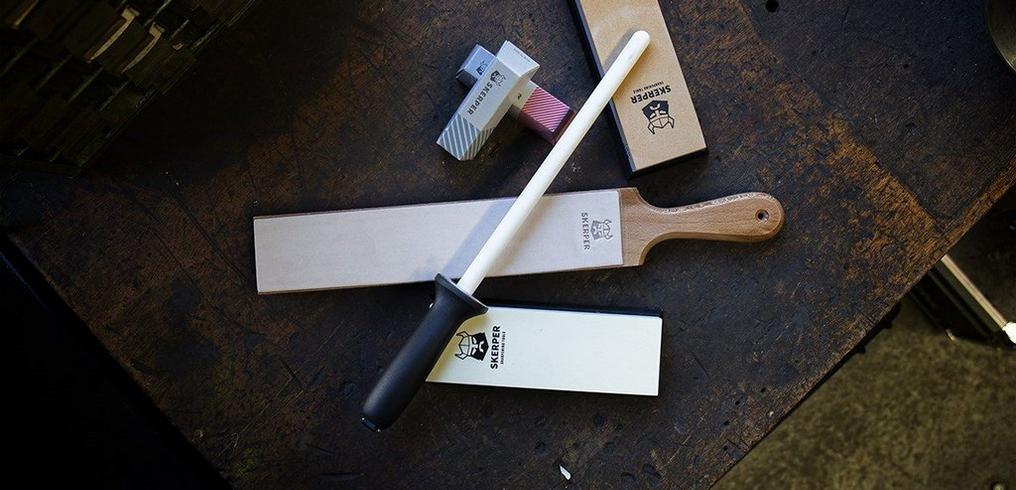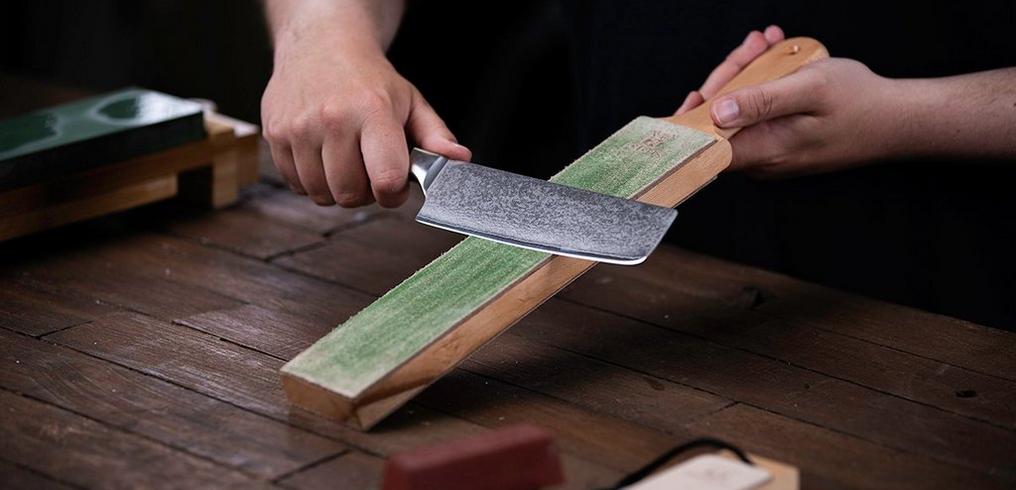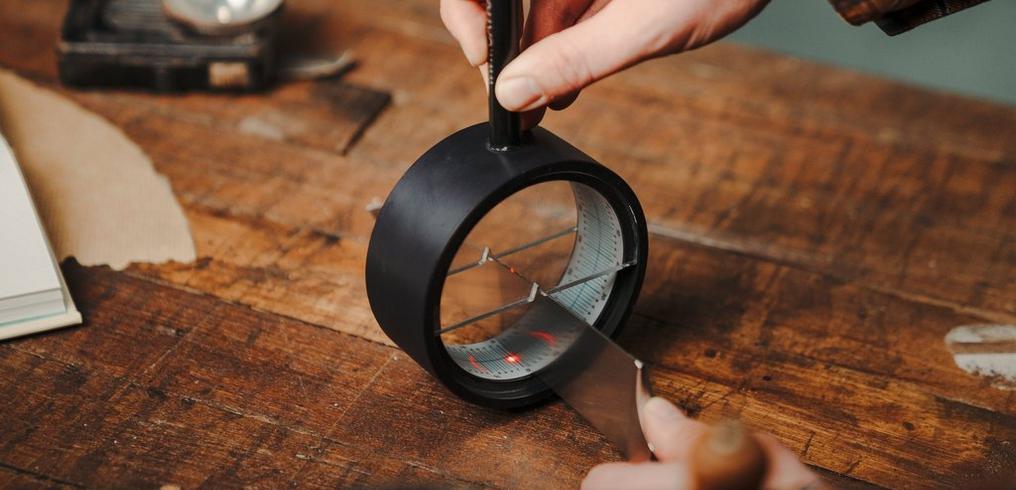How to sharpen a knife?
There are many methods to sharpen your knives. For example, you can use a sharpening stone, or a sharpening rod, sharpening system or an electrical sharpening machine. You can also ask someone else to do the job. The best sharpening method for you, depends on the kind of knives you want to sharpen, the type of steel of the blade, your experience with sharpening and your own preferences.
In this article, we have lined up the most common sharpening methods for you. Each method has its pro's and con's. We will describe these for you, as well as possible.
Whetstones
Pros:
- Very sharp results attainable with fine stones.
- There is an ideal sharpening stone for each phase of the sharpening process.
- Ensures a long life span of your knife.
- Can be used for regrinding blunt knives and maintaining sharp knives.
- Useful for thinning knives
Cons:
- Skill is necessary. Watch the video tutorial.
- For those who love sharpening – to achieve the perfect results, you need some time.

Sharpening steel
Pros:
- For quick maintenance.
- Long life span of your knife.
- Excellent (quick) results.
Cons:
- Not suitable for blunt blades.
- Not suitable for thinning knives
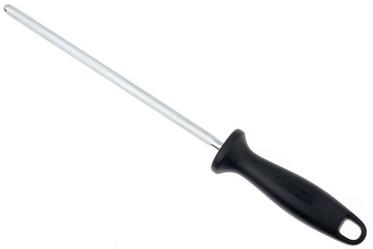
Pull-through sharpeners
Pros:
- Easy to use
Cons:
- The fold of the edge often often ends up a bit agged, making the knife less sharp.
- The sharpness is of short duration.
- Not suitable for thinning.
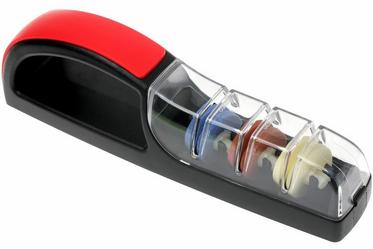
Electric sharpeners
Pros:
- Fast, easy to use and good results.
Cons:
- Lots of material loss, compared to sharpening with a stone.
- Not suitable for thinning

Sharpening systems
Pros:
- Sharpening under a constant angle.
- Good results attainable.
Cons:
- For those who love sharpening - to achieve the perfect results, you need some time.
- Suitable only for small knives.
- The clamping system may cause scratching. To prevent scratching, it is advisable to paste your knife with adhesive tape.
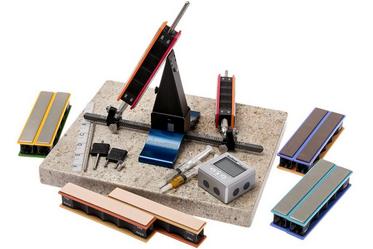
Honing steels
Pros:
- Honing steels are not suitable for sharpening of knives, and have become obsolete by very fine sharpening steels.
Cons:
- Only for comparatively soft blades.
- It doesn't sharpen the knife.
?%24center=center&%24poi=poi&%24product-image%24=&fmt=auto&poi=%7B%24this.metadata.pointOfInterest.x%7D%2C%7B%24this.metadata.pointOfInterest.y%7D%2C%7B%24this.metadata.pointOfInterest.w%7D%2C%7B%24this.metadata.pointOfInterest.h%7D&scaleFit=%7B%28%24this.metadata.pointOfInterest%29%3F%24poi%3A%24center%7D&sm=c&w=373)
Whetstones
Sharpening stones are availabel in different grits and are ideal for sharpening blunt knives or maintaining sharp knives. The grit size of the sharpening stone affects the finish of the sharpened blade. The finer the grit, the better the folds of the blade are polished and thus the sharper the knife.
The grit size of the sharpening stones is indicated by means of numbers. A high number indicates a fine grit, for a fine polish of the blade.
A major benefit of sharpening your knives on a sharpening stone is that you can thin out your knife. When thinning out a knife, you grind away extra material on the sides of the blade, making the blade thinner. Thinning of a knife is useful for knives that are often sharpened, as the cutting edge gets fatter when the blade is sharpened more often. Thinning is of great importance for the preservation of good cutting properties.
Sharpening knives on a sharpening stone takes some practice but the reward is great: razor-sharp blades. In our video we show step by step how you can sharpen your knives on a sharpening stone.
Sharpening steels
Sharpening steels are steel shaped sharpening stones, intended to sharpen your knife in a few easy movements. There are different types of sharpening steels.
Ceramic steel:
The most common sharpening steels are made of ceramic material. A ceramic sharpening steel is ideal to keep your knife sharp. This is fast and easy. However, it's very important to use this steel regularly, to prevent the knife from going blunt.
Diamond sharpening steel:
Besides ceramic steels, there are also grinding steel that have a layer of diamond. The hard diamond grains ensure that you can quickly regrind your knives. Compared to a ceramic steel, the result slightly less refined. A disadvantage of a diamond steel is that over time the diamond grains may break out or crumble off, which causes the steel to lose it's sharpening quality.
Sharpening steels are especially suitable for (small) maintenance of knives. For sharpening dull blades, it is advisable to use a sharpening stone or sharpening machine. Besides the above, we have the honing steel: it is important not to confuse sharpening steels with honing steels.
Pull through sharpeners (knife sharpeners)
If you don't want to learn the skill of sharpening on a stone, a pull through sharpener may be a good option. The pull through sharpener consists of one or more smalle grinding wheels with a fine or coarse grit. In order to sharpen the knife you pull the knife several times through the grinding wheels without really pushing. The results of this shaprening method are of lower quality than sharpening rods and stones. The result is a relatively jagged edge, and the sharpness is of short duration. To get really sharp knives, it is therefore advisable to use one or more sharpening stones. The fast and somewhat rough treatment of a pull through sharpener is, in particular for harder steels, not recommended. A good knife actually deserves a more sophisticated sharpening method, such as sharpening on a stone.
Electric sharpening
For the cooking enthusiast without sharpening experience, an electric sharpener could be a great help. The electric sharpening machine has one or more slots with different types of sharpening wheels. The slots are already in a fixed grinding angle, providing a fixed, reliable edge. This benefit can also be a disadvantage, since European knives are sharpened under a different angle than Japanese knives. By pulling the knife through the slots one by one, it will be thoroughly sharpened. The electric sharpeners are pretty easy to use and deliver a good result. However, a sharpening turn removes significantly more material from the blade then with the use of a sharpening stone. This means that your knife will end up with a shorter life span if you use the electric sharpener regularly. For pocket knives, we do not advise to use an electric sharpening machine. This is because the machine removes quite a lot of material and pocket knives generally already have a thin blade.
Guided sharpening systems
Guided sharpening systems use a holder where you secure your knife, one or several sharpening sticks or conductors. Through the use of the holder, it is easy to select the right angle for sharpening. When using a guided sharpening system, there are two ways to sharpen your knife: a. Sharpening sticks are placed in the holder, after which you pull the knife along the different sharpening sticks, in order to sharpen it. b. The knife is secured in the holder, after which you pull the sharpening sticks along the blade. There are various systems for sale with a sharpening stone grinding the knife under a adjustable angle. The advantage is that you have a nice straight cutting edge. Disadvantage of this method is that it takes more time than grinding on a regular sharpening stone. Moreover, by sharpening with a fixed angle, you are much less flexible. So if you don't want to sharpen the knife in ze pre-fixed angle, you will still have to do it manually. The guided sharpening systems are highly recommendable for sharpening expensive pocket knives, because they provide a very nice cutting edge. By pasting the blade with adhesive tape, you can prevent any scratches caused by the clamping system. For kitchen knives, it is advisable to use a sharpening stone or electric grinder.
